Japanese field and self-propelled artillery in anti-tank defense
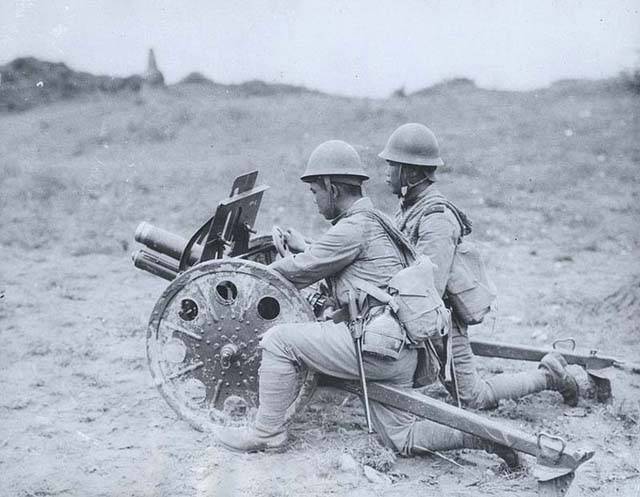
Field and mountain equipment caliber 70-75 mm
Widespread in the Japanese army received 70-mm light howitzer Type 92. This gun was created due to the insufficient fragmentation of the 37-mm Type 11 infantry cannon and the low accuracy of the 70-mm mortar Type 11 mortar. The leadership of the imperial army complained that the infantry regiments and battalions were equipped with two types weapons with various ammunition. As a result, the army technical bureau developed a gun that could be used when firing direct fire at enemy's infantry, machine gun nests, and lightly armored vehicles, but it was also possible to fire with a high aiming angle. In other words, the Type 70 light howitzer, if necessary, had to provide direct fire support to the infantry and fight the lungs tanks, and also, if necessary, hit visually unobserved targets in the folds of the terrain and shelters.
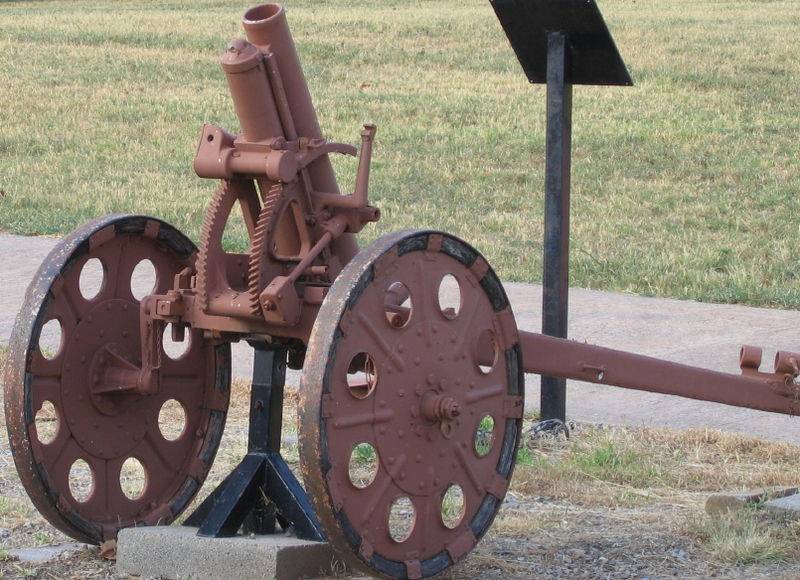
The lightweight 70-mm howitzer had a record low combat weight - 216 kg. A carriage with sliding articulated beds ensured firing with an elevation angle up to + 83 °. In the horizontal plane, the aiming angle could vary within 22 ° in each direction, which made it easier to shoot at fast moving targets. If necessary, the gun could be disassembled into parts suitable for carrying by individual infantrymen.
At short distances, the 70-mm howitzer was towed by calculation, for which there were holes and brackets in the carriage, for which a hook was hooked or a rope was passed. In order to facilitate the construction, the splinter shield was often removed. The howitzer was originally equipped with wooden wheels upholstered with iron, but in 1936, they were replaced with all-metal ones.
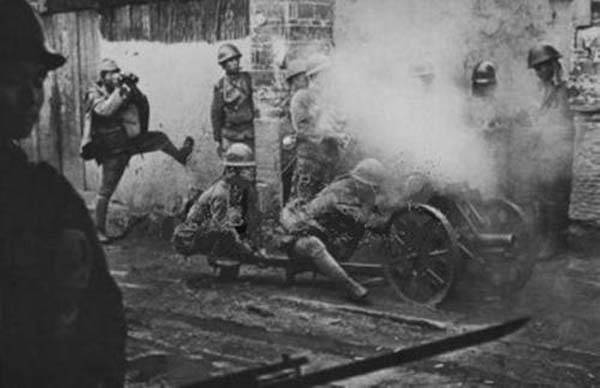
The calculation of the five people provided a combat rate of fire to 10 shots / min. But the payment for low weight was a small firing range. Fragment grenade mass 3,76 kg contained 0,59 kg of TNT. After leaving the barrel with a length of 622 mm with an initial speed of 198 m / s, the projectile could hit the target at a distance of up to 2780 m. The effective firing range of visually observed objects was 900 m.
Serial production of Type 92 howitzers began in the 1932 year and continued until the summer of the 1945 year. The gun was very widespread in the Japanese army and was the main means of artillery support for infantry battalions. In general, it was fully in keeping with its intended purpose and, moving in the combat formations of the infantry, was able to destroy lightweight woodland fortifications, suppress machine-gun nests, make passes in wire barriers. When the detonator was set to explode with deceleration, the fragmentation projectile was able to break through armor up to 12 mm thick, which in 1930-s allowed to fight light tanks and armored vehicles. After the appearance of tanks with anti-shell armor, an 70-mm shot with a cumulative grenade with an 2,8 kg mass was adopted. This ammunition, when hit at a right angle, ensured the penetration of 90 mm armor. By reducing the mass of the cumulative projectile compared with a fragmentation grenade, it was possible to increase the initial velocity, which contributed to an increase in the range of the direct shot.
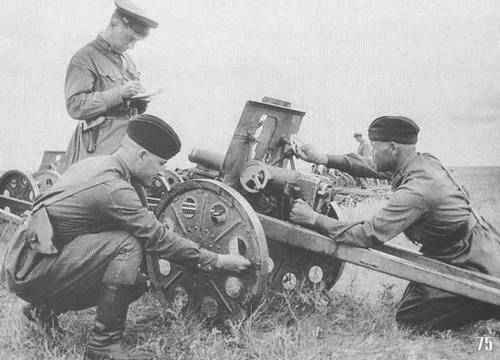
For the first time, the Japanese used Type 92 in 1932 during the Mukden Incident, and 70-mm howitzers in 1930's were actively used in China. Several serviceable Type 92 were trophies of the Red Army at Khalkhin Gol. Light 70-mm howitzers showed themselves very well in the fighting in Southeast Asia. In the conditions of the jungle, in most cases, a long range was not needed. And due to their high prevalence, Type 92 fired even more often than specialized 37 and 47-mm guns. Fortunately for the Americans, there was always a shortage of cumulative projectiles in the Japanese army, and their fuses often did not work reliably. Unlike most of the Japanese artillery systems, after the capitulation of Japan in August 1945, the 70-mm light howitzer service did not end. Before the start of the 1970s, they were in service with the People’s Liberation Army of China and were actively used against American troops during the Vietnam War.
Quite numerous in the imperial army were 75-mm guns. During the Second World War, there were quite a few outdated guns that were nevertheless actively used in combat and, if necessary, were used to fight tanks. One of the most common artillery systems was the 75-mm Type 38 field gun, put into service in the 1905 year. It was a 75-mm German 75-mm gun, model 1903, created by Friedrich Krupp AG. Licensed production of 75-mm guns was established in Osaka. In total, the Japanese army received more than 2600 such guns.
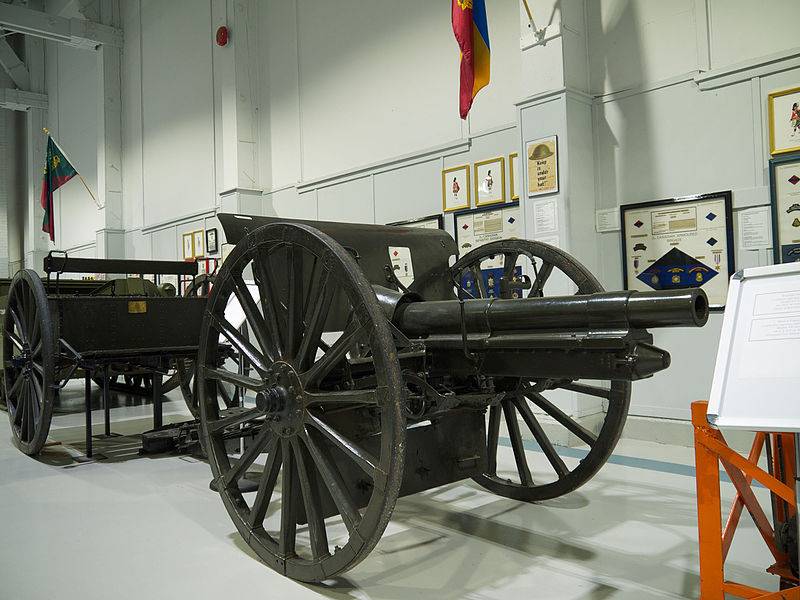
The Type 38 cannon had a typical 20 structure for the beginning of the century, complete with a front end and a single-bar carriage. For damping recoil used a simple hydraulic system. The weight in the combat position was 947 kg, with a front end - 1135 kg. The gun was transported by a sled of six horses. Calculation - 8 people. To protect the calculation from bullets and shrapnel there was a shield. Shooting was carried out with 75xXNNXXR unitary ammunition. The piston valve allowed 294-10 shots / min. With a barrel length of 12 mm, a fragmentation grenade with a mass of 2286 kg left it at an initial speed of 6,56 m / s.
By the beginning of the 1920's gun outdated. In 1926, a modernized version of Type 38S appeared. During the modernization, the barrel was extended, a wedge gate was introduced, the elevation angle increased to + 43 °, which in turn increased the maximum firing range from 8350 to 11600 m. The initial speed of the fragmentation grenade is 603 m / s. Based on the experience of fighting, the shield became higher. The mass of guns in the battle position was 1136 kg. Up to the middle of the 1930s, around 400 Type 38S were released. Simultaneously with the modernization, the range of ammunition was expanded. In addition to shrapnel and fragmentation grenades, a high-explosive fragmentation fragrance with an increased filling ratio, incendiary with a thermite mixture, smoke and an armor-piercing tracer were introduced into the ammunition.
Although horizontal guidance angles (± 4 °) made shooting at moving targets problematic, often for the lack of a better old 75-mm field guns were used to fight tanks. At a distance of 350 m, an unmodernized Type 38 cannon with an armor-piercing projectile could penetrate the frontal armor of the M4 Sherman tank. Despite the fact that Type 38 and Type 38S did not fully meet modern requirements, the outdated 75-mm field guns took part in hostilities until Japan surrendered.
In 1908, the 75-mm Type 41 mountain weapon, a licensed version of the German Krupp M.75 08-mm cannon, was adopted. Constructively, Type 38 and Type 41 had a lot in common. For its time, it was a very good weapon, used in all armed conflicts in which the imperial army participated.
In the combat position 75-mm mountain gun Type 41 weighed 544 kg, in the marching, with a gun ancestor - 1240 kg. Four horses were used for towing. The calculation of 13 people could carry it disassembled or transported in packs on six horses. In conditions of very rough terrain, up to 40 people were required to carry one gun. The high-explosive fragmentation projectile weighing 5,4 kg contained 1 kg of explosives, and left the barrel with a length of 1100 mm with an initial velocity of 435 m / s. The maximum firing range is 7000 m. Vertical pickup angles: from -8 ° to + 40 °. Horizontal: ± 6 °. When firing high-explosive fragmentation grenades and shrapnel with a fuse that was “hit”, the Type 75 XMUM mountain weapon presented a threat to armored vehicles with anti-bullet armor. Although the initial speed was relatively small, the ammunition consisted of an armor-piercing projectile, capable of penetrating the 41 mm armor along the normal 227 m. In the conditions of a small range of opening fire in the conduct of hostilities in the jungle, this was quite enough to hit the American "Sherman" in the board.
Mining artillery was intended to support the mountain infantry units. The main requirement for mountain artillery guns was their disassembly so that the gun could be transported in packs along narrow mountain paths. The weight of the packs did not exceed 120 kg. Organizationally, the Japanese mountain artillery resembled field, but since the soldiers had to transport all their equipment and weapons with the help of pack animals, the staff strength of the mountain artillery regiments was higher and reached 3400 people. Typically, a Japanese mountain artillery regiment had 36 75-mm guns in its three divisions. However, in the imperial army there was also a separate regiment of mountain artillery of 2500 men in two divisions. It was equipped with 24 guns.
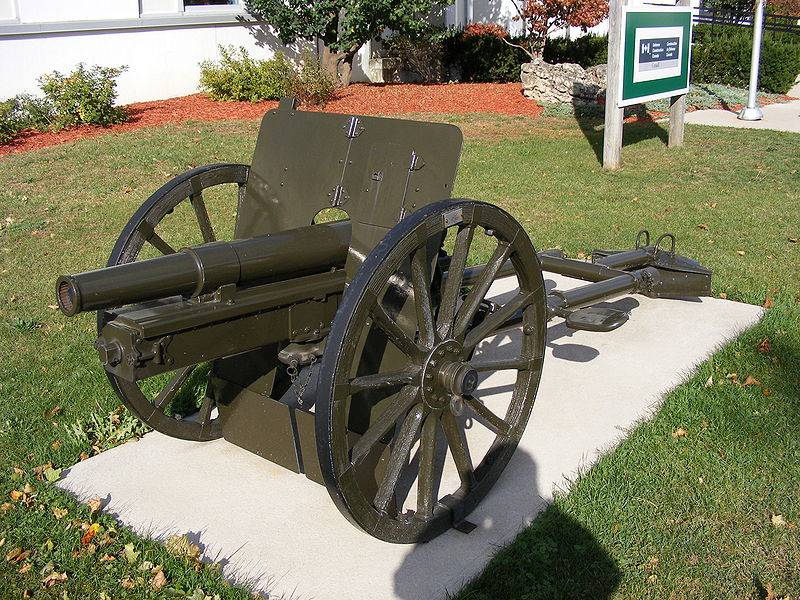
With the advent of the 75-mm mountain gun, the Type 94 guns of the Type 41 guns were removed from the mountain artillery and transferred to the category of regimental artillery. Each infantry regiment was given a battery of four guns. In total, the Japanese army received 786 75-mm gun Type 41.
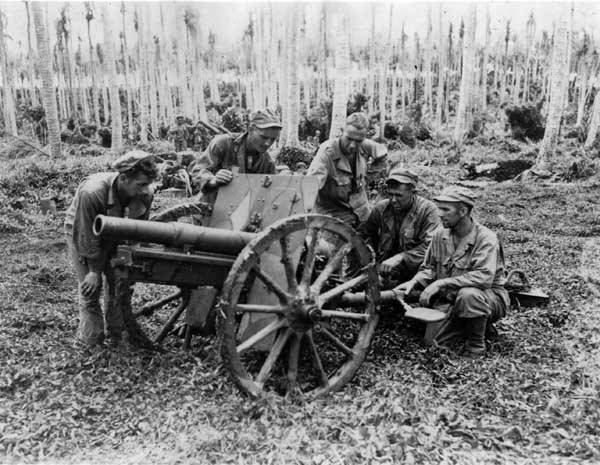
In 1934, the 75-mm Type 94 mountain cannon entered service. At the design stage, this weapon, in addition to the mountain parts, was supposed to be parachuted. Hydropneumatic recoil compensation mechanism was based on the French development of Schneider. Type 94 had an improved carriage with sliding beds, barrel length 1560 mm and a wedge gate. The gun was completed with a removable shield 3 mm thick, which protected the calculation from small arms fire and light shrapnel.
The weight of the gun in the combat position was 535 kg. Within half an hour, the gun could be disassembled into 11 parts. An 18-20 man or 6 packhorse was required to transport the gun. The vertical angle of the Type 94 was from -2 ° to + 45 °. On the horizontal plane, targets could have been hit in the 40 ° sector. The maximum firing range - 8000 m.
For firing of 75-mm Type 94 mountain cannon, unitary shots 75x294R were used, which in their dimensions and nomenclature did not differ from ammunition intended for Type 38 field gun. The armor-piercing shell, known in the USA as M95 APHE, weighed 6,5 kg and contained 45 g of picric acid. At a distance of 457 m, he could penetrate 38 mm armor. However, liners intended for the Type 94 were equipped with a smaller charge of gunpowder and the shooting of regular shots of 75-mm field guns Type 38 was prohibited. The Americans noted a fairly high accuracy of the fire of Japanese 75-mm mountain guns, which are well suited for the specific conditions of the war in the jungle.
The relatively low weight of the mountain cannons allowed their calculations to quickly maneuver on the ground, choosing the most convenient places for firing and getting out of the retaliatory strike in time. Firing from closed positions, they sometimes inflicted heavy losses on the American marines. Direct fire was also very effective. According to the memoirs of American veterans, some tanks and tracked amphibians received 4-mm projectiles from 5-75. In most cases, the fire was carried out by fragmentation facets, and the armor of the Sherman medium tanks was not pierced, but many tanks partially or completely lost their combat capability due to the failure of weapons, surveillance devices and sights. The amphibious tracked LVT transporters proved to be much more vulnerable, which only one fragmentation projectile could hit for failure.
During World War II, the Type 94 mountain cannons were used not only in mountain artillery, but also as infantry regimental guns. After the capitulation of Japan, a significant number of 75-mm mountain cannons were at the disposal of the Chinese Communists, who actively used them during the fighting in Korea.
From the middle of the 1920-s in Japan, along with the modernization of old 75-mm field guns, the development of modern artillery systems of the regimental and divisional level was carried out. Initially, the 38-mm canon de 75 modèle 85, proposed by Schneider, was considered as the main model intended to replace the Type 1927. However, after a detailed acquaintance with this gun, Japanese engineers found it too complicated and expensive to manufacture. On the basis of the French gun, after the "creative processing" aimed at adapting to the capabilities of the Japanese industry, an 75-mm field gun was created, which was put into service in the 1932 year under the designation Type 90.
Although outwardly the gun had a traditional design with wooden wheels, characteristic of the 75-mm field guns of the First World War, in its combat capabilities it was much superior to the Type 38. The speed of Type 90 has been enhanced by the use of a horizontal right-side wedge gate. The recoil device consisted of a hydraulic brake recoil and hydropneumatic knurling. Type 90 was the first of the Japanese artillery shells that received a muzzle brake. The carriage had a sliding bed box type. The design of the top launcher machine made it possible to bring the angle of horizontal guidance to 25 ° left and right, which sharply increased the possibilities of the gun in terms of firing at moving targets. Vertical guidance angles: from -8 ° to + 43 °. A fragmentation grenade with a mass of 6,56 kg was accelerated in the barrel with a length of 2883 mm to 683 m / s. The maximum range of shooting - 13800 m. Rate of fire: 10-12 rds / min. The weight of the gun in the combat position - 1400 kg, in the transport with the front end - 2000 kg. The towing was carried out with a six-horse team, the calculation was 8 man.
In addition to fragmentation, shrapnel, incendiary, and smoke projectiles, unit ammunition consisted of unitary shots with armor-piercing tracer shells. According to Japanese data, at a distance of 457 and an armor-piercing projectile, if it hit a right angle, it punched 84 mm armor, at a distance of 914 m, armor penetration was 71 mm.
In American sources it is said that the field gun Type 90 could penetrate the armor, whose thickness was less by about 15%. But in any case, 75-mm armor-piercing shells fired from the Type 90 cannon at a distance of 500 m, guaranteed to overcome the frontal protection of the Sherman tank.
In 1936, a modernized version of the Type 90 gun, adapted for towing vehicles at speeds up to 40 km / h, was adopted. The gun received suspension, metal disc wheels with pneumatic tires and lightweight shield. The mass of guns in the combat position increased by 200 kg.
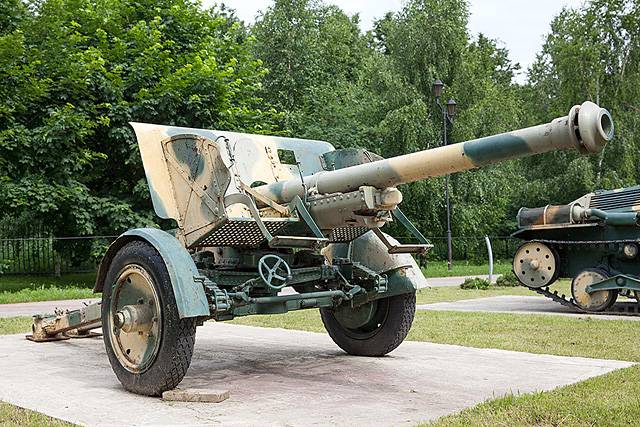
After upgrading the 75-mm field gun, it acquired a completely modern design for its time. According to its characteristics, Type 90 was at the level of the best world analogues, and can be considered one of the most successful Japanese artillery systems. Its production continued until 1945. However, Japanese industry was not able to sufficiently saturate the armed forces with modern 75-mm guns. Total 786 guns were released. Despite the relative small size Type 90 played a significant role in anti-tank defense. They were first used in the 1939 year during the fighting at Khalkhin-Gol, where one artillery battery was able to knock out 5 Soviet tanks. According to Japanese archival data, during the battles in the Philippines and in the battle for Iwo Jim, Type 90 had destroyed Matilda II and M4 Sherman tanks. Successfully enough, the 75-mm guns fired on the floating lightly armored LVT amphibians.
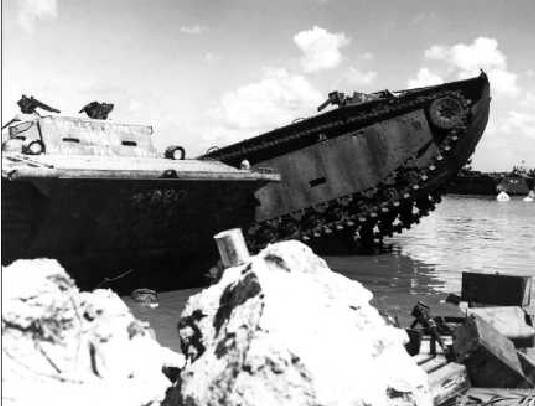
Based on the Type 90 in 1936, the 75-mm Tool 95 was created. The main difference of this model from its prototype was the trunk shortened to 2278 mm. This was done to reduce the cost and reduce the mass of the gun, because at the maximum range of fire it is almost impossible to observe the breaks of 75-mm shells and to correct artillery fire.
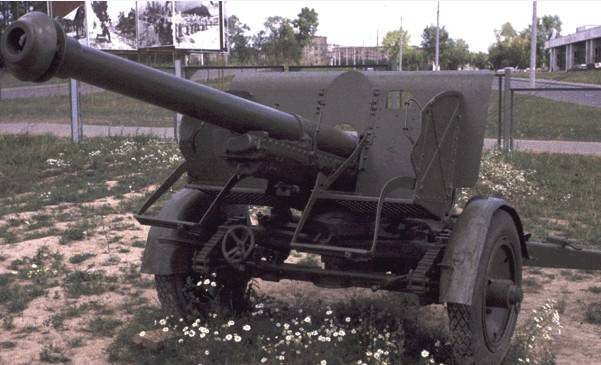
For shooting from the type 90 and type 95 used the same ammunition. But the initial velocity of the fragmentation grenade fired from Type 95 was 570 m / s. Reducing the initial speed resulted in a decrease in the maximum firing range to 10800 m. Although the armor penetration of the Type 95 gun was worse than that of the Type 90, a shorter barrel and a smaller weight on the 400 kg facilitated transportation and masking. The Type 95 gun was supposed to supplant the obsolete 75-mm guns in infantry artillery, but this did not happen. A total of 1936 to 1945 year artillery arsenal in the city of Osaka produced 261 gun.
Japanese self-propelled artillery
In contrast to a number of other countries participating in the Second World War, a very limited number of self-propelled artillery mounts were received by the imperial army. In June, the 1941 of the year was tested by an ACS Type 1 Ho-Ni I. Serial production of self-propelled guns began in the 1942 year.
This self-propelled artillery, armed with an 75-mm gun Type 90, also known as Type 1 gun tank, was built on the chassis of a Type 97 Chi-Ha tank. A gun with elevation angles from −5 to + 25 ° and a sector of horizontal shelling 20 ° was installed in the wheelhouse, covered in front and sides. The thickness of the cutting armor was 50 mm. The forehead and sides of the hull are 25 mm, the feed is 20 mm. Diesel engine air cooling horsepower 170 could accelerate a car weighing 15,4 t to 38 km / h. Crew - 5 man. Ammunition - 54 shot.
A number of sources state that the Type 1 Ho-Ni I was a tank destroyer, but this self-propelled gun was developed to equip companies with fire support for tank divisions. The design of the cabin and the presence of an artillery panorama indicate that the Type 1 Ho-Ni I was originally intended for the role of self-propelled guns for supporting tanks and infantry on the battlefield. However, the self-propelled tracked chassis, armed with a Type 90 gun, was quite able to successfully fight with all the American tanks used in the Pacific theater when operating from ambushes.
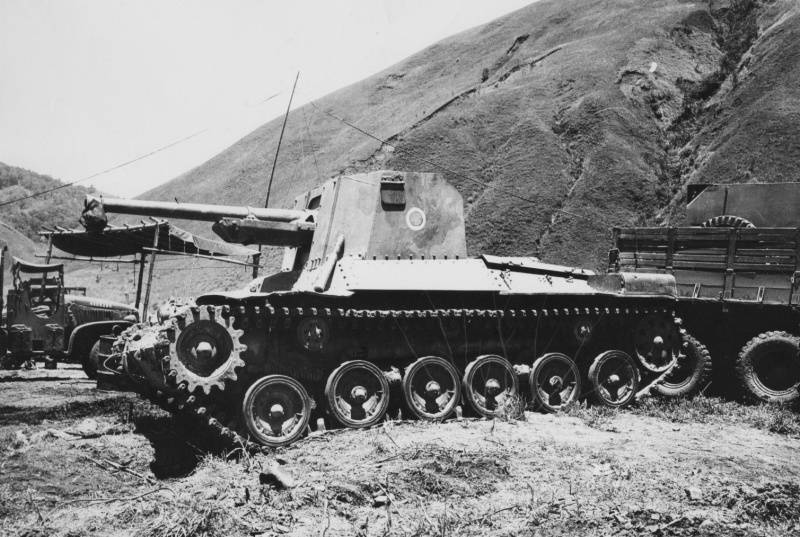
Since Mitsubishi was able to supply all 26 Type 1 Ho-Ni I machines, they did not have a noticeable effect on the course of the hostilities. Japanese SAU with 75-mm guns first entered the battle at Luzon in the Philippines in the 1945 year, as part of the 2 Panzer Division. Self-propelled guns, firing from disguised caponiers, helped the Japanese troops to significantly delay the advance of the Americans into the interior of the island. Type I Ho-Ni I self-propelled rigs were also used by the Japanese army in Burma at the end of the war. Almost all the vehicles were destroyed by superior forces of the US Army, currently one Japanese self-propelled gun is an exhibit of the museum at the Aberdeen testing ground.
In 1943, a Type 1 Ho-Ni II ACS, armed with a Type 105 91-mm howitzer, went into the series. This is a typical self-propelled gun fire support, which should fire mainly from shelters. Therefore, the cutting with the same dimensions as the Type 1 Ho-Ni I was armored easier. The thickness of the frontal armor of the cabin was 41 mm, the side of the cabin - 12 mm. Combat weight of the machine - 16,3 t.
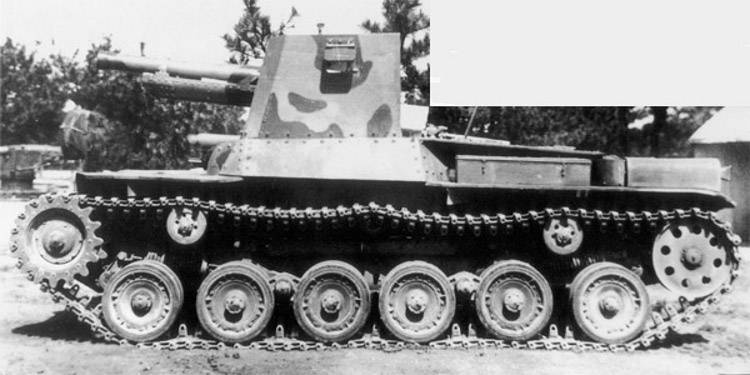
Due to the large length of the barrel recoil, the elevation angle of the instrument when installed in the wheelhouse did not exceed 22 °. The gun could be induced over the horizon without turning the chassis in the 10 ° sector. Ammunition - 20 shots. High-explosive projectile weighing 15,8 kg had an initial velocity 550 m / s. In addition to high-explosive fragmentation, ammunition could include incendiary, smoke, lighting, armor-piercing and cumulative projectiles. Rate of fire - up to 8 shots / min.
According to American sources, the imperial army received 62 105-mm ACS. It is known that 8 Type 1 Ho-Ni II was used in the fighting in the Philippines. In addition to the destruction of fortifications and the fight against enemy manpower, they could successfully be used against armored vehicles. At a distance of 150 m, an armor-piercing projectile, when hit at right angles, pierced 83 mm armor, the cumulative projectile normally had 120 mm armor penetration. Although the direct shot range of the Type 91 howitzer was smaller than that of the Type 90 cannon, a direct hit by a powerful high-explosive 105-mm projectile was more likely to damage the Sherman tank. Close explosions of such projectiles posed a threat to light tanks and tracked transporters.
In view of the weakness of the weapons of Japanese tanks, they could not fight on equal terms with the American Shermans. To remedy this situation, the production of an ACS Type 1944 Ho-Ni III began at the beginning of 3. Unlike other self-propelled guns, created on the basis of the Type 97 Chi-Ha tank, this vehicle had a fully closed armored cabin with armor thickness not exceeding 25 mm. The mobility of the Type 3 Ho-Ni remained at the level of the ACS Type 1 Ho-Ni I.
The gun was armed with an 75-mm Type 3 tank gun, which, in turn, was developed based on the Type 90 field cannon. The Type 3 cannon was originally designed for the Type 3 Chi-Nu medium tank, which began production in the 1944 year. With the initial speed of an armor-piercing projectile 680 m / s, at a distance of 100 m normal, he punched 90 mm armor.
In various sources, the number of built PT ACS ranges from 32 to 41 units. Most of the Type 3 Ho-Ni III entered the 4 Tank Division, based in Fukuoka, Kyushu, where they stayed until Japan surrendered. Most researchers agree that using the Type 97 Chi-Ha chassis of the company Mitsubishi produced no more than 120 self-propelled guns with 75 and 105-mm guns. Approximately 70% of self-propelled installations in anticipation of the American invasion were located on the Japanese Islands, where they were until August 1945 of the year. It can be stated that the Japanese self-propelled artillery mounts suitable for fighting tanks, due to their small number, did not have a significant impact on the course of hostilities. Small production volumes of SAU did not allow staffing all the tank regiments and divisions with a regular number. The Japanese themselves tried to compensate for the small number of their own self-propelled guns with the captured machines.

So, during the fighting with the Americans in the Philippines in 1944-1945, Japanese troops used the American 75-mm self-propelled T12 units on the half-track BX-MXXUMX chassis, captured by them here at the beginning of 3.
In general, the state of the Japanese anti-tank artillery demonstrated the attitude of the Japanese leadership towards the fleet, aviation and ground forces. It is known that financing for the creation and production of military equipment and weapons in Japan went under two different budgets. Until 1943, the main budgetary allocations and production resources were received by the fleet, which built aircraft carriers, super-battleships and the world's largest submarines. In 1944, having lost the initiative at sea and faced with a real threat of invasion of the Japanese islands, the Japanese command redistributed priorities. But by that time, time had been lost, and the Japanese economy, which was experiencing an acute shortage of resources, could not satisfy the demands of the army.
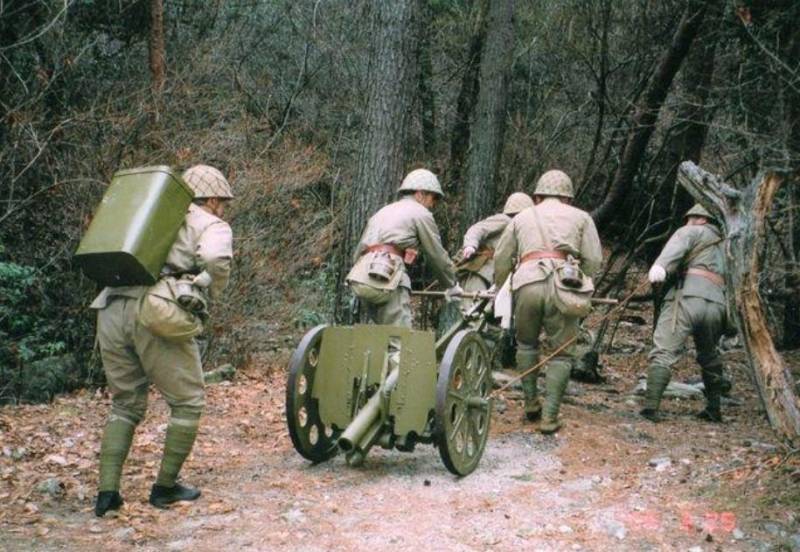

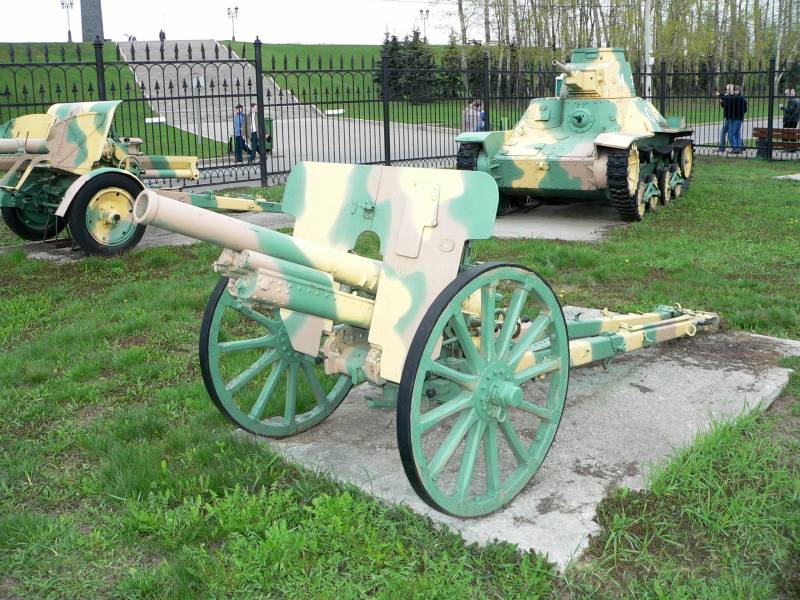
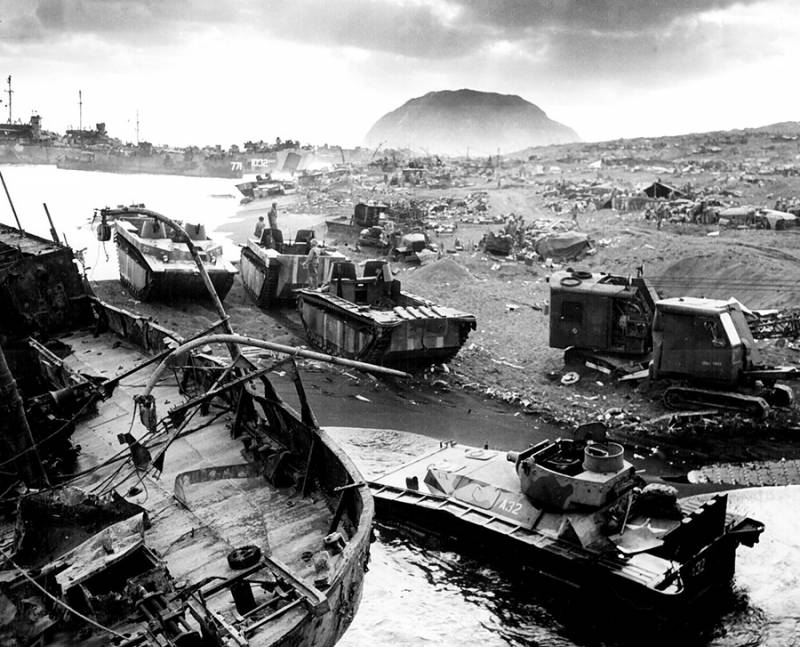
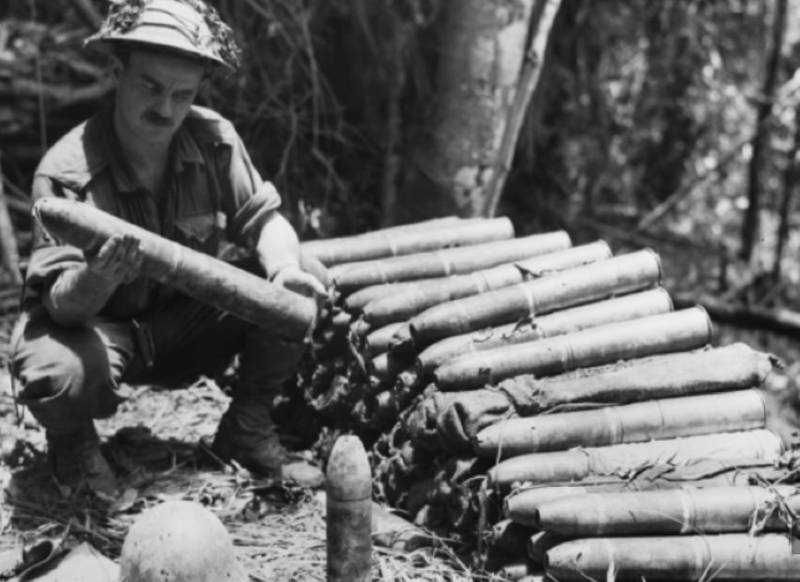
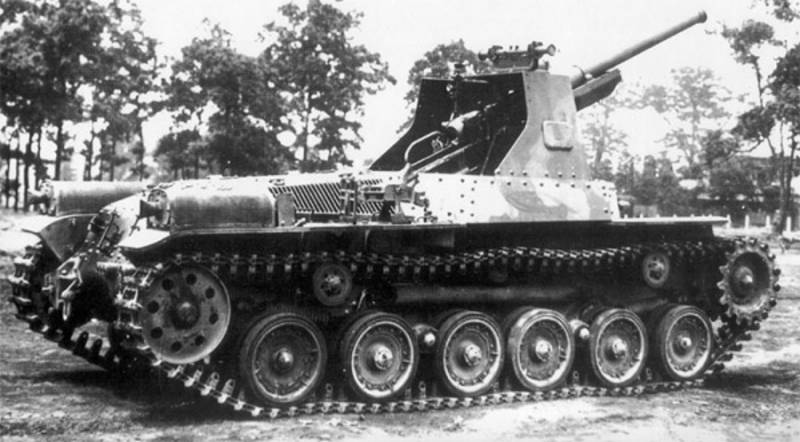
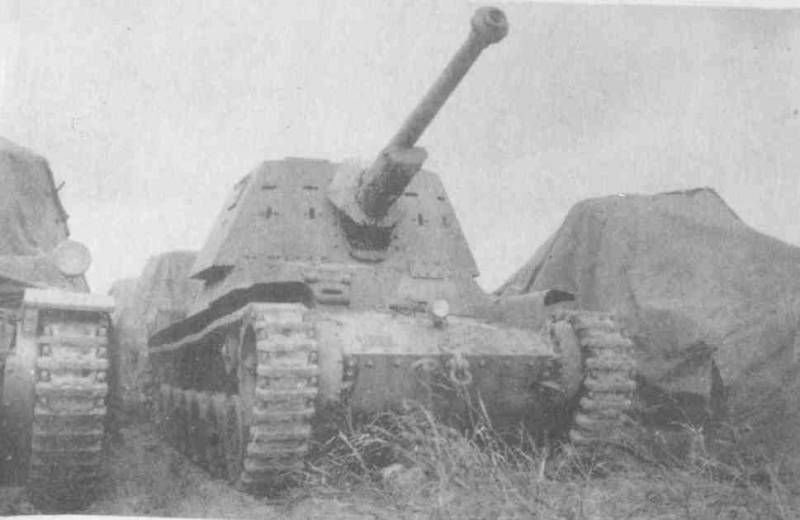
Information